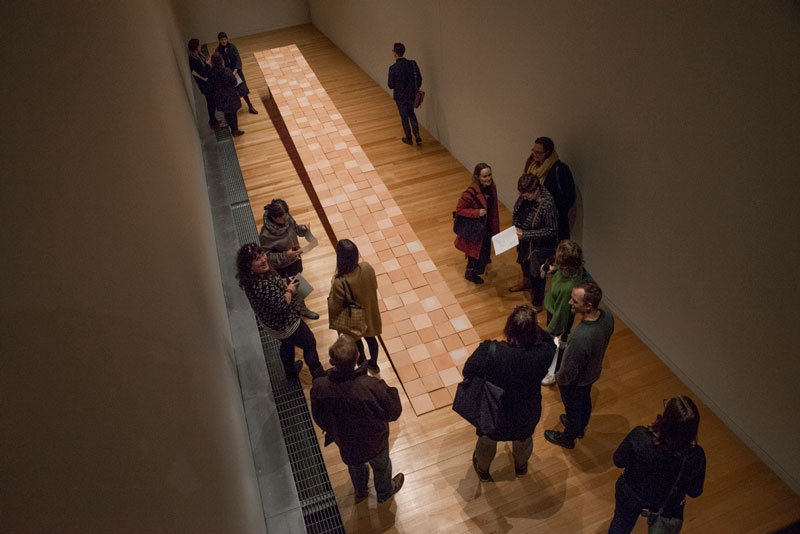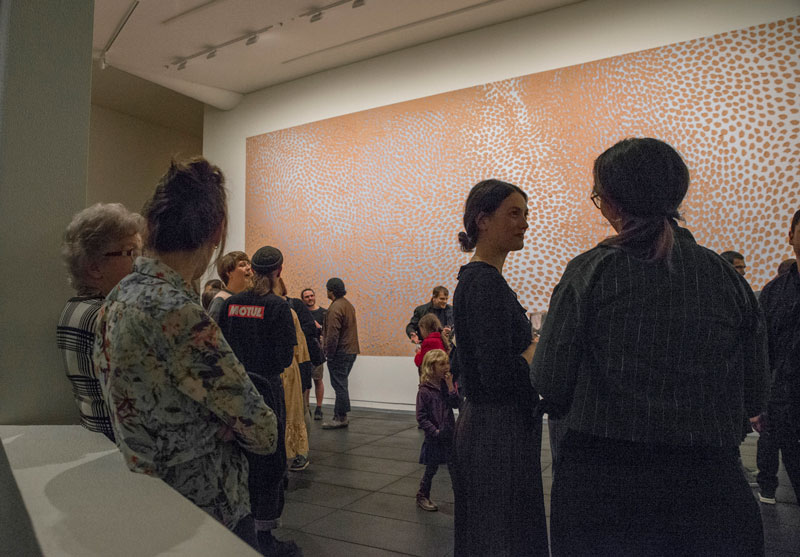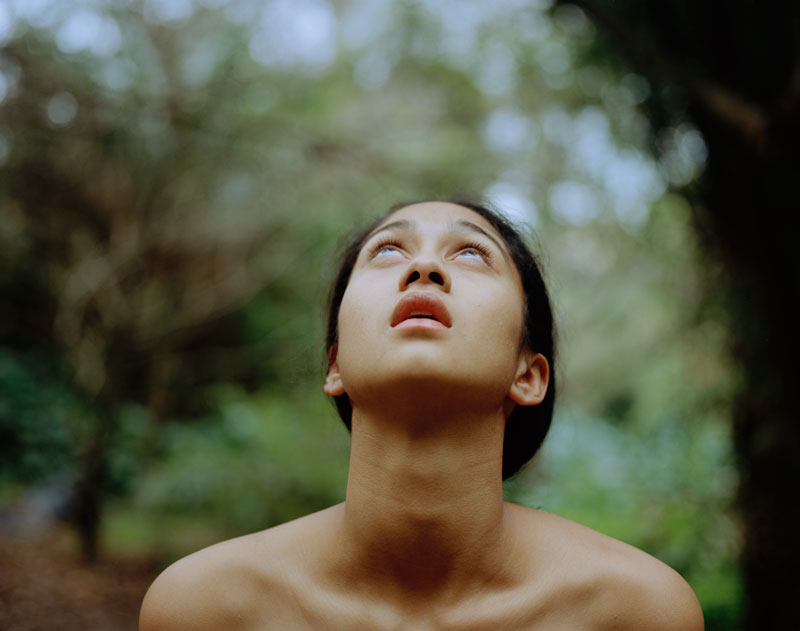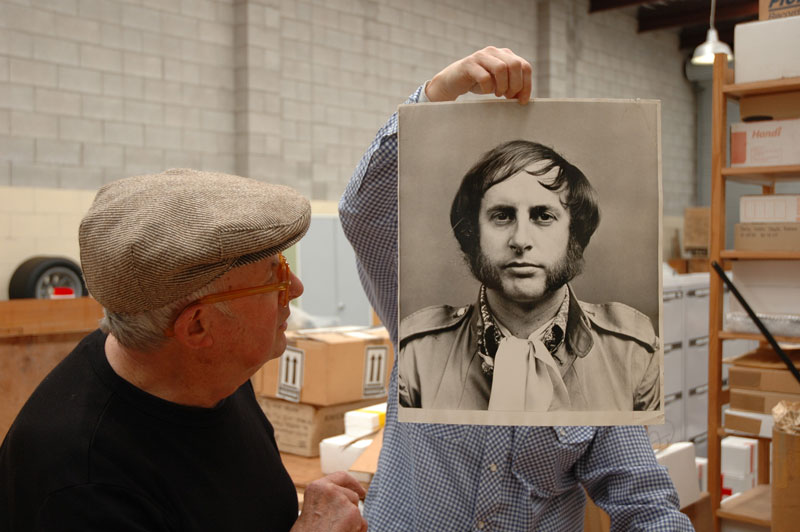
The mark of a good symposium is when question time gets uncomfortable, when people are honest and the possibility for real change is discussed. A glimmer of such moments took place within No Common Ground, a one-day symposium recently held at Victoria University of Wellington. Convened by Adam Art Gallery Te Pātaka Toi, Enjoy Public Art Gallery and the Dowse Art Museum, No Common Ground focused on newly opened exhibitions at each organisation in response to the national recognition of 125 years of women’s suffrage in Aotearoa New Zealand. These exhibitions included The Earth Looks Upon Us / Ko Papatūānuku te matua o te tangata at the Adam Art Gallery (7 July – 23 September 2018), Embodied Knowledge at The Dowse Art Museum (7 July – 28 October 2018) and Margins & Satellites at the Enjoy Public Art Gallery (5 July – 4 August 2018).
The symposium comprised a selection of well-respected artists and curators from a range of generations reflecting on the proposition that they all come at the subject of feminism with different perspectives from the strategically general to the astutely specific. For the most part the event was nothing out of the ordinary. Individual presentations were kept short and sharp, panel discussions moderated with a respectful flow and question time was tightly time managed.

The guts of the symposium came from Adam Art Gallery Director Christina Barton’s presentation on the process of curating The Earth Looks Upon Us / Ko Papatūānuku te matua o te tangata. According to Barton, the exhibition was originally intended to focus on the seminal Cuban artist Ana Mendieta (1948– 1985). Barton recognised a synergy between concepts of Mana Wāhine[1] in contemporary Māori art practice and Mendieta’s influential performative work that often explored a political and historical connection between the female body and the earth. This would also be the first time that Mendieta’s work was exhibited in New Zealand. But, as Barton explained, five weeks out from the exhibition’s opening the lender for Mendieta’s work decided not to participate, commenting that they did not think the physical spaces of the art gallery were suitable to present film works. This is particularly unusual given that the Adam Art Gallery has successfully exhibited numerous moving image works such as a recent solo show by the Turner Prize nominated artist Luke Willis Thompson. Barton suggested that the cancellation was due to the problem of working with a partner on the other side of the world. With distance, it seems, small technical challenges become harder to resolve. It was also insinuated that being on the periphery of the art world also fed into this situation to some extent.

Faced with an incredibly challenging situation, Barton opted to shift tack and curated a show entirely of Māori women artists including Ngahuia Harrison, Ana Iti, Nova Paul and Raukura Turei and to hold an associated one-off screening of Mendieta’s films in a cinema context at the Embassy Theatre. Surprisingly, this is the first exhibition dedicated entirely to Māori women artists to be held at the Adam Art Gallery in its nineteen-year history – 10 years of which Barton has been director. In what seemed a full disclosure, Barton owned up to this omission and drew attention to the fact that her career was founded on the back of supporting the practices of a mostly Pākehā (European New Zealander) male contingent of post-object artists of the late 1960s onwards. To illustrate this point Barton presented an image of herself photographed holding up a Billy Apple® self-portrait in front of her face, thereby permitting her own presence to be obscured by the country’s most revered male artists who she has worked with extensively. She also mentioned striving to provide considerable opportunities to women artists such as Vivian Lynn, Kim Pieters and Ruth Buchanan, to name a few, while also admitting that the majority have been Pākehā. Barton’s forthrightness was disarming. Few curators are so candidly self-critical, especially practitioner of Barton’s stature who is one of New Zealand’s most respected senior curators.

Before the implications of her presentation could be digested by the audience, question time was restricted to only a few queries and shifted swiftly into a tea break and panel discussion including the artists exhibiting at the Adam Art Gallery. The result of this was that the artists were asked some awkward curatorially-aimed questions from the floor. This left many unresolved issues that were not unpacked until the concluding plenary panel discussion, which included artist Louisa Afoa who commented that: “it is unfortunate that it took the cancellation of an international artist to provide this long overdue opportunity to wāhine” (or words to that effect). An audience member also commented that Barton’s revelation ultimately indicated a smoothing-over of the biased systems of power that define the value of some art and practitioners over others in the art world. Barton’s response to this and similar remarks was that throughout her practice she has worked hard to use her position and privilege within the system to always bring under-recognised narratives and practices to light. Her research and support of post-object practice, which at the time was greatly overlooked in New Zealand art history, is a significant example of this. When faced with an obstacle, it can open up an opportunity to learn and see an outcome that is much stronger, she added.
It has become a trend for curators to declare the limitations of their practice. Often this is used as a tactic to sublimate critique and diffuse debate so as not to disturb the polished consistency of an exhibition. Barton’s presentation did not do this. She was honest and through this honesty she ruptured the expectations of the symposium audience, enabling discussion to take place. This doesn’t of course excuse the fact that it has taken the Adam nineteen years to address a major oversight in its exhibition programming, but it does signal a willingness to facilitate change. By operating with a degree of transparency and adaptability, Barton was able to recognise the potential of the situation to address some very real ethical implications of her curatorial approach. With the generous support of the artists she was able move forward to realise a successful exhibition. Let’s hope this spirit of openness continues to be explored in the Adam Art Gallery’s future programme. It is a challenge to admit difficulties and compromises, but it is an even greater challenge to sustain a contested ground of conversation and to implement change.
Footnotes
- ^ The term Mana Wāhine, in its most reduced understanding, refers to the power of Māori women in society and is described by the seminal Linda Tuhiwai Smith as a “strong cultural concept which situates Maori women in relation to each other and upholds their mana as women of particular genealogical groupings. It also situates Maori women in relation to the outside world and reaffirms their mana as Maori, indigenous women. Mana Wahine Maori is the preferred Maori label for what counts as Maori feminism.” [note: macons were not used in original text] See: Linda Tuhiwai Smith, “Getting out from down under: Maori Women, Education and the Struggles for Mana Wahine,” in Madeleine Arnot and Kathleen Weiler (eds), Feminism and Social Justice in Education: International Perspectives, London; Washington DC: The Falmer press, 1993, p. 61.
